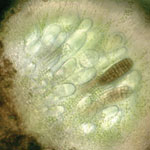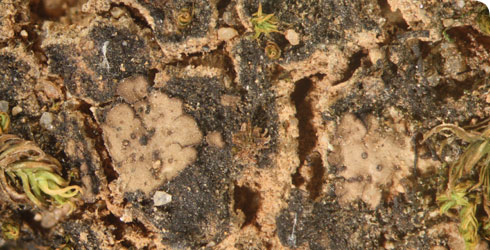Biology

Cross-section of the thallus of E. pusillum. © C Gueidan
Lichen symbiosis
A lichen is the result of a symbiotic association between a fungus and an alga.
This association offers reciprocal benefits, as the fungus provides shelter to the algae, and the algae provide nutrients to the fungus.
The dual nature of lichens was discovered long after scientists started naming lichen species.
Today, the lichen name (for example Endocarpon pusillum) always refers to the fungal partner.
The algal partner of Endocarpon pusillum is a green alga from the genus Stichococcus.
An unusual feature of Endocarpon pusillum is that the algal cells are found in the fruiting bodies. In other lichens, these algal cells are usually restricted to the vegetative body (thallus).

Cross-section of a perithecium of Staurothele areolata. © C Gueidan
Endocarpon pusillum spores are therefore, in direct contact with the algal cells.
When these large spores are dispersed, they carry algal cells with them.
This characteristic might be an adaptation to help the lichen colonise bare substrates. It is a characteristic shared by other species of Endocarpon and the genus Staurothele, another member of the family Verrucariaceae.
Toolbox
Glossary
Asci
Plural of ascus - sexual spore-bearing cells.
Muriform
Regular, brick wall-like arrangement.
Perithecium
Bottle-shaped fruiting body.
Rhizines
Hairlike growths that bind the thallus to its substrate.
Squamules
A small, loosely attached thallus lobe - vegetative structure.
Symbiotic
Close and long-term interaction between two different species.
Thallus
Vegetative body.
